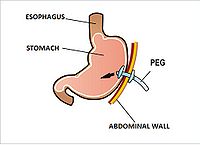PEG
Percutaneous endoscopic gastrostomy (PEG) is a tube introduced through the skin into the stomach. It is used in patients, who are not able to receive the food, liquids or medication for a prolonged period of time (usually more than 6 weeks). PEG is a surgical procedure, althought we do not have to open the abdominal cavity for placement. The first surgery was performed in 1980.
How Is It Done?[edit | edit source]
It is not necessary to do this surgery in the operating room, but a patient has to stay in a hospital overnight after it. Before the procedure it is not allowed to drink or eat for more than 8 hours. Just a local anesthesia is sufficient around the place, where we want to put the PEG. Whole procedure lasts about 45 minutes.
The endoscope is placed into your esophagus (through the mouth) and then into the stomach. Endoscope is a long and thin tube, which also includes camera, so we can visually check where we would like to place PEG. A small light of endoscope usually transilluminate through the skin of the abdomen, so we can mark the place, where we will cut with the scalpel (obesity can complicate it, so then we have to help ourself with digital pressure). Thanks to conductor we pull out the PEG, which was introduced by mouth, through the abdominal wall out of the body.
Indications[edit | edit source]
- long-term feeding (more than 6 weeks);
- swallowing problems (E.g.:motorneuron diseases);
- fractures in face;
- tumors of the larynx, orofacial tumors;
- oesophageal tumors;
- radiation of head and neck;
- dysphagia;
- continuous application of medication (E.g. Parkinson´s disease and L-Dopa);
- disorders of consciousness;
- stroke;
- when we have to remove nasogastric feeding tube.
Contraindication[edit | edit source]
- portal hypertension;
- obesity;
- ascites;
- hepatomegaly;
- anatomical changes ;
- terminal stage of illness;
- coagulopathy.
Complications[edit | edit source]
- pneumoperitoneum ;
- wound infection;
- necrosis (pretty rare);
- bleeding;
- aspiration during the surgery;
- removement of a tube.
Links[edit | edit source]
Related articles[edit | edit source]
- Motorneuron Diseases
- Parkinson´s Disease
- Portal Hypertension
- Ascites
- Hepatomegaly
- Coagulopathy
- Pneumoperitoneum
External links[edit | edit source]
Bibliography[edit | edit source]
- ČEŠKA,, et al. Interna. 1st edition. 2010. ISBN 978-80-7387-423-0.


